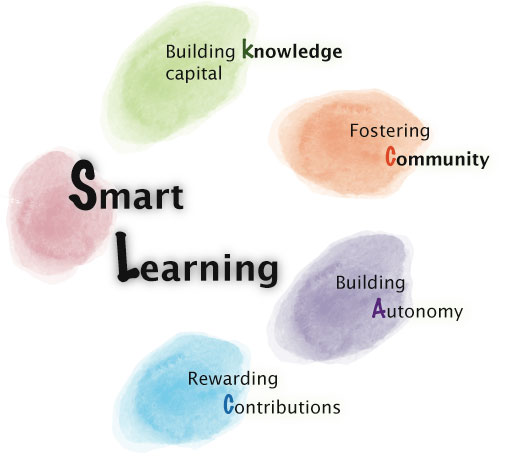I often find that the most powerful element driving a video, a learning module, a programme, a website, even an institution is it's conceptual framework. It's a nebulous concept really, but when dealing with ideas, messages and learning, the impact is so much more memorable and powerful if there is a objective-based strategy that ties everything together. Our job, is to listen to who you are, what you are doing and where you want to go and then articulate the central essence of your message, project, or programme into a strategic frame. The goal is to tie all elements together and mobilize people and ideas to a strong thematic core.
Here are some examples of strategic frameworks we have developed (for a full list, please consult my Linkedin profile
Neurobox's Smart Learning Framework
As human beings we learn constantly. It is in our nature. What's more, the digital dimension to our world has changed the morphology of the economy into an industry of knowledge more than products. Knowledge is power. Power to sculpt the life we want, power to invent, power to make money, power to help others, etc. As famous media theorist Manuel Castels says, 'network logic changes the fundamental principles behind productivity, experience, power and culture (Castels, 2000).' Organizations who understand the importance of nurturing intelligence understand how important high impact learning is in the professional journey. This has led Neurobox to explore what the "what", "how" and "why" of the modern learning experience and boil it down to Smart Learning Framework. Because not only is it beneficial to learn, but one must learn 'smartly' in order to grow. For this, four basic ingredients must be present to fostering Smart Learning and catalyzing a high impact learning environment:
- First you need to have access to knowledge. Building an organization's knowledge capital is the first building block to fostering Smart Learning. Either by giving access to online courses, bringing in experts to teach, building your own content library, an organization must have content to offer.
- Next there needs to be a supportive community in which to discuss that knowledge. Some of the best self-directed learners have confessed that their first "laboratory" is their network. Either to develop the lingo that goes with the profession, or to use people as a sounding board or to get constructive feedback, the community is an integral part of learning.
- There also needs bot be some basic skills in learning autonomously. This refers to all the meta-cognitive skills related to learning: setting goals, making a plan, having some sort of evaluation scheme (sometime that is just talking about stuff at lunch) and knowing when to recoup, regroup and re-strategize. In other words, knowing how to learn must be part of the Smart Learning package.
- And last, there needs to be some sort of reward. Let's face it, if there is nothing in it for you, you won't do it. But rewards go way beyond money, it can be enjoyment, become more nimble at a skill (like playing guitare...I so wish I could), a title, recognition...etc. Still if there is no reward for learning , your organization may missing a huge piece to fostering high impact learning. Or what we like to call Smart Learning.
Wether you are a believer in learning as tool for organizational growth, or you are building an engagement strategy, or a retention strategy, this model can be used as tool to reflect on what you're organization has in place to foster learning and demonstrate that you understand the reality of the professional journey of your people.
From Crib to Kindergarten: West Island Women's Center WIWC framework for early childhood programme.

Developed by the Ministère de la famille in Québec, this framework was introduces by the Women's Center to better describe the current early childhood courses and build new courses that address the key areas of early childhood cognitive development. It is also used as an educational tool to help sensitize new parents on the main areas of early childhood development. Currently, the Centre offers an awesome array of early childhood and pre-K courses: from yoga, gym, and karate, to cooking, art and music, and finally, cognitive awakening for ages 0 to 5, all of the instructors reflect and respect this model to ensure these pillars are deepened within their courses.
Growing Talent: framework for programmes in creative industries
Nature or nurture, talent still needs the right ingredients to grow and ripen (many of which are researched and documented). With this framework we were looking to zero into the key elements that contribute to developing people for creative industries. This framework was meant to ensure that each programme would have a balance between building knowledge, building a network to bounce knowledge and ideas off of and putting everything into practice by exercising talent in divergent and experimental ways...and then cycling back to those dimensions over and over again. It is simple, but powerful. This model was then applied to re-engineer all of the programmes offered online (and hopefully in class). It gave way to mini learning innovations such as the "Creation Labs" where students are expected to approach creative projects with a more experimental mindset rather than fulfilling expectations. It also demonstrated the importance of offering online discussion spaces and personal blog spaces where students could build their critical dialogue and increase the range of their professional dialect. As with all projects, this model was intend to first and foremost nurture and respect the learner and prepare them for their future as best as possible.




